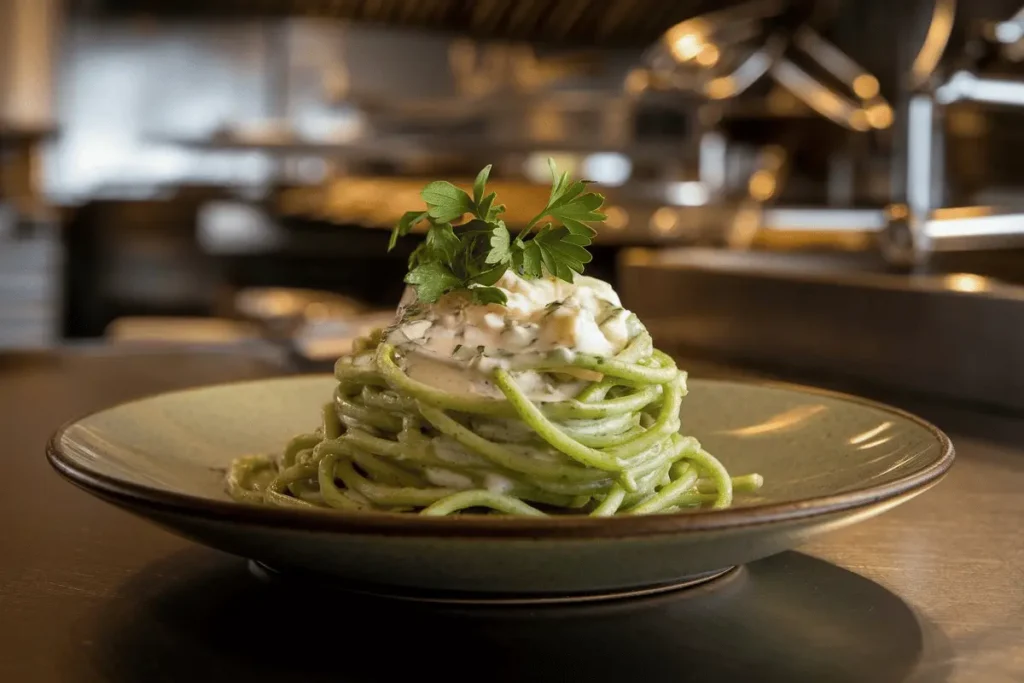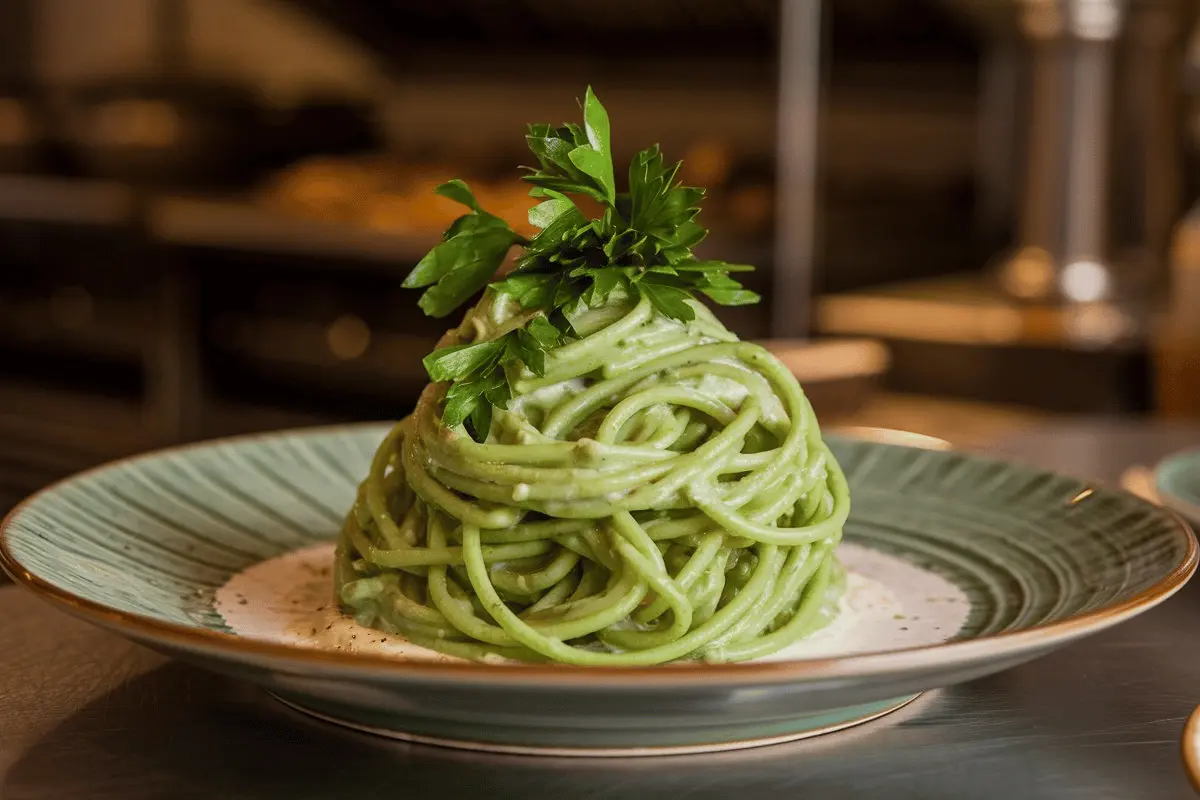Introduction to Green Spaghetti
What Makes Green Spaghetti Unique?
Green spaghetti stands out from the crowd not just because of its color, but because of the freshness and vibrancy of its flavors. While the appearance is eye-catching, the real magic lies in the combination of ingredients that come together to create a dish that’s both delicious and satisfying. Unlike its more traditional counterparts, green spaghetti is typically made using fresh herbs, green vegetables, and sometimes even vibrant sauces that add layers of flavor.
The Origins of Green Spaghetti
The origins of green spaghetti are as diverse as the variations of the dish itself. While it’s often associated with Italian cuisine, particularly when pesto sauce is involved, green spaghetti has also made its mark in Mexican cuisine. In Mexico, a version known as “Espagueti Verde” uses a green sauce made from poblano peppers and is a staple at many family gatherings and celebrations.
The Primary Ingredients of Green Spaghetti
The heart of any spaghetti dish lies in its ingredients. Each component contributes to the overall flavor profile, making the dish a harmonious blend of taste and texture. Let’s explore the main ingredients that make green spaghetti so special.
Fresh Green Herbs
One of the key ingredients in green spaghetti is fresh green herbs. Basil, parsley, cilantro, and spinach are often used to create the vibrant green sauce that gives the dish its distinctive color and fresh taste. Basil, in particular, is a favorite due to its aromatic flavor that pairs perfectly with pasta.
Green Vegetables
In addition to herbs, green vegetables play a significant role in creating the sauce. Poblano peppers, spinach, and even avocados are popular choices. These vegetables not only add flavor but also provide the creamy texture that coats the spaghetti beautifully. Poblano peppers, when roasted, add a smoky flavor that enhances the overall taste of the dish.
The Role of Cheese
Cheese is another crucial ingredient in green spaghetti. Whether it’s Parmesan, cotija, or cream cheese, the choice of cheese can drastically alter the flavor of the sauce. Parmesan adds a nutty flavor, while cotija, often used in Mexican spaghetti, gives a salty and tangy twist. Cream cheese, on the other hand, adds creaminess and richness to the sauce, making the dish even more indulgent.
Spaghetti Pasta
Of course, no spaghetti dish would be complete without the pasta itself. Traditional spaghetti is usually made from durum wheat semolina, which gives it a firm texture that holds up well to rich sauces. Whole wheat spaghetti or gluten-free varieties can also be used depending on dietary preferences.
How to Make Green Spaghetti: Step-by-Step Recipe
Creating green spaghetti at home is a straightforward process that involves just a few steps. Here’s how you can make this delightful dish from scratch.
Preparation of the Green Sauce
The first step in making green spaghetti is preparing the green sauce. Begin by selecting your preferred green herbs and vegetables. For a basic green sauce, you might choose basil, spinach, and roasted poblano peppers.
- Blending the Ingredients: In a blender, combine the fresh basil leaves, spinach, roasted poblano peppers, and a handful of parsley. Add a clove of garlic for extra flavor, and pour in a little olive oil to help the blending process.
- Adding the Cheese: Once the herbs and vegetables are blended to a smooth consistency, add your choice of cheese. Parmesan or cotija works well here. Blend again until the cheese is fully incorporated into the sauce.
- Seasoning: Finally, season the sauce with salt, pepper, and a squeeze of fresh lemon juice to brighten the flavors.
Cooking the Spaghetti Pasta
While the sauce is being prepared, cook the spaghetti pasta according to the package instructions. Make sure to salt the water generously, as this will season the pasta from the inside out.
- Boiling Water: Bring a large pot of water to a rolling boil. Add a generous amount of salt to the water.
- Cooking the Pasta: Add the spaghetti to the boiling water and cook until al dente. This typically takes about 8-10 minutes, but be sure to check the package instructions for the specific cooking time.
- Draining the Pasta: Once the pasta is cooked, drain it, but reserve a cup of the pasta cooking water. This starchy water can be used to help thin the sauce and help it adhere to the pasta.
Combining the Sauce and Spaghetti
Now that both the sauce and pasta are ready, it’s time to bring them together.
- Tossing the Pasta: In a large pan, pour the green sauce and heat it gently. Add the cooked spaghetti to the pan and toss to coat the pasta evenly with the sauce.
- Adjusting the Consistency: If the sauce seems too thick, add a bit of the reserved pasta water to thin it out. Continue tossing the pasta until the sauce clings to the noodles perfectly.
- Finishing Touches: Once the pasta is well coated, it’s ready to be served. You can sprinkle additional cheese on top if desired.
Variations of Green Spaghetti
While the basic green spaghetti recipe is delicious on its own, there are numerous variations that you can try to suit your taste preferences. Here are a few ideas to inspire your next green spaghetti dish.
Green Spaghetti with Pesto Sauce
Pesto is perhaps the most famous green sauce in Italian cuisine. Made with fresh basil, pine nuts, garlic, Parmesan cheese, and olive oil, pesto sauce is a fragrant and flavorful option for green spaghetti. Simply toss cooked spaghetti in a generous amount of homemade or store-bought pesto, and you’ll have a delicious meal ready in minutes.
Creamy Green Spaghetti
For a richer version of G~spaghetti, try making a creamy green sauce. This can be achieved by adding cream cheese or heavy cream to the green sauce. The result is a luxuriously smooth and creamy sauce that coats the spaghetti perfectly. This variation is particularly popular in Mexican cuisine, where cream cheese is often added to the poblano-based green sauce.
Spicy Green Spaghetti
If you like a bit of heat, consider making spicy spaghetti. Add jalapeños or serrano peppers to the green sauce to give it a kick. You can also sprinkle red pepper flakes on top for an extra layer of spice. This version of green is perfect for those who enjoy bold and spicy flavors.
Vegan Green Spaghetti
For a plant-based option, try making vegan green spaghetti. Replace the cheese in the sauce with nutritional yeast, which adds a cheesy flavor without any dairy. You can also use avocado to create a creamy texture. This variation is not only vegan but also incredibly flavorful and satisfying.
Serving Suggestions for Green Spaghetti
Green spaghetti is a versatile dish that can be paired with a variety of side dishes and garnishes. Here are some ideas to complete your meal.
Ideal Pairings with Green Spaghetti
- Garlic Bread: A classic pairing with any pasta dish, garlic bread adds a crispy and flavorful contrast to the soft and saucy spaghetti.
- Grilled Vegetables: Grilled vegetables like zucchini, bell peppers, and asparagus complement the fresh flavors of G~spaghetti.
- Salad: A light and refreshing salad with a simple vinaigrette can balance out the richness of the green sauce.
Garnishing Ideas
- Fresh Herbs: Sprinkle chopped fresh basil, parsley, or cilantro on top of the green for added flavor and color.
- Cheese: Grate some Parmesan or cotija cheese over the top for a finishing touch.
- Nuts: Toasted pine nuts or sliced almonds can add a nice crunch to the dish.
Tips for Perfect Green Spaghetti
Making spaghetti is easy, but a few tips can help ensure that your dish turns out perfectly every time.

Choosing the Right Ingredients
- Freshness Matters: Use fresh herbs and vegetables for the best flavor and color. Avoid using dried herbs as they won’t provide the same vibrant taste.
- Quality Cheese: Choose high-quality cheese for the sauce. A good Parmesan or cotija will make a significant difference in the final dish.
Cooking Techniques
- Don’t Overcook the Pasta: Cook the spaghetti until it’s al dente, meaning it should be firm to the bite. Overcooked pasta can become mushy and won’t hold the sauce as well.
- Blending the Sauce: Blend the green sauce until it’s completely smooth. This will ensure that it coats the pasta evenly.
Common Mistakes to Avoid
- Using Too Much Water: When thinning the sauce with pasta water, add it gradually. Too much water can make the sauce runny.
- Overloading the Sauce: Avoid adding too many ingredients to the green sauce. Keeping it simple allows the flavors of the herbs and vegetables to shine.
The Popularity of Green Spaghetti in Different Cuisines
spaghetti has found its place in various cuisines around the world, each adding its unique twist to the dish.
Green Spaghetti in Italian Cuisine
In Italy, green spaghetti is often associated with pesto sauce. This classic sauce, made from basil, pine nuts, garlic, and Parmesan, is a staple in Italian kitchens. Italian spaghetti is typically light, fresh, and full of flavor.
Green Spaghetti in Mexican Cuisine
Mexican spaghetti, or Espagueti Verde, is a popular dish that features a creamy sauce made from roasted poblano peppers and cream cheese. This version is richer and has a mild, smoky flavor that’s unique to Mexican cuisine.
Green Spaghetti in Fusion Dishes
In recent years, green spaghetti has become popular in fusion cuisine, where it’s combined with ingredients and flavors from different cultures. For example, spaghetti might be served with Asian-inspired ingredients like soy sauce, ginger, and sesame seeds, creating a unique and delicious fusion dish.
Conclusion
Green spaghetti is a versatile and flavorful dish that brings a fresh and vibrant twist to traditional pasta. Whether you prefer the classic Italian pesto version, the creamy Mexican Espagueti Verde, or a spicy variation, there’s a spaghetti recipe to suit every palate. By understanding the ingredients and techniques involved, you can easily create this delicious dish at home and impress your family and friends with your culinary skills.
Frequently Asked Questions About Green Spaghetti
1. Can I use different types of pasta for green spaghetti?
Yes, you can use any type of pasta you prefer. While spaghetti is traditional, you can also use fettuccine, penne, or even whole wheat or gluten-free pasta.
2. How long does green spaghetti sauce last in the fridge?
spaghetti sauce can be stored in the fridge for up to 3 days in an airtight container. Make sure to reheat it gently on the stove before serving.
3. Can I freeze green spaghetti sauce?
Yes, you can freeze G~spaghetti sauce. Freeze it in an airtight container for up to 3 months. Thaw it in the fridge overnight before reheating.
4. What can I substitute for Parmesan cheese in green spaghetti?
If you’re looking for a non-dairy substitute, nutritional yeast is a great option. It adds a cheesy flavor without any dairy.
5. Can I make green spaghetti without a blender?
Yes, you can use a food processor or even chop the ingredients finely and mix them by hand. However, using a blender or food processor will give you a smoother sauce.
